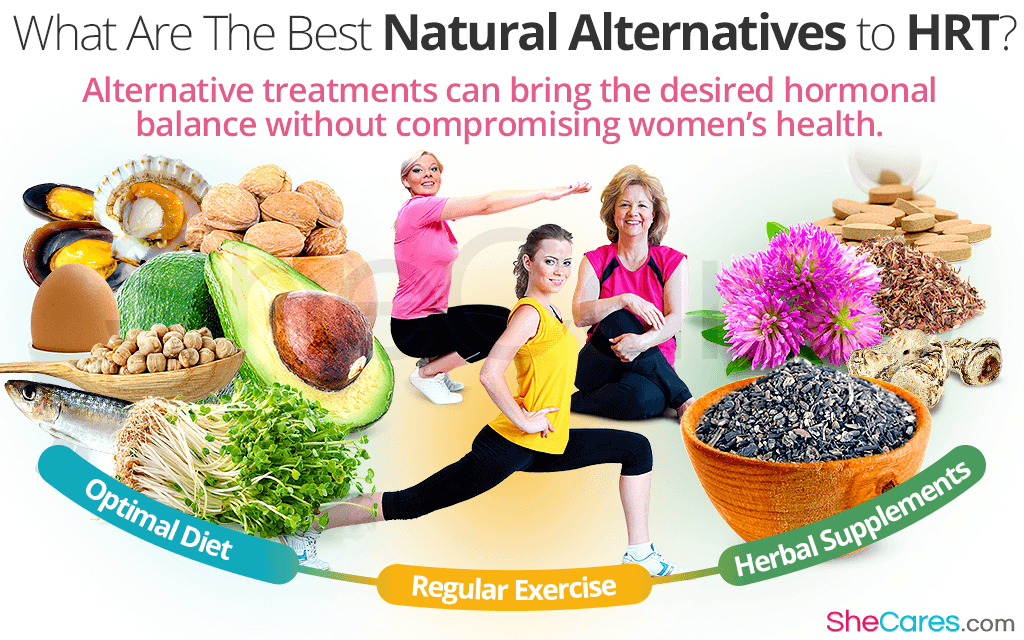Although hormone replacement therapy (HRT) might be an effective treatment for relieving menopause symptoms, because of the serious health risks associated with its use, many women nowadays are seeking alternative treatments that will bring desired hormonal balance without further compromising their health. Luckily, there are several worthwhile options they can choose from.
Keep reading to discover the most popular natural alternatives to HRT in order relieve your menopause symptoms safely and effectively.
Optimize your Diet
Since hormonal imbalance ensues in women' bodies as the production of estrogen and progesterone declines, composing the diet with foods that target the hormonal gap can lessen the effects of the decline and relieve symptoms.
While a balanced menopause diet should consist of lean protein, complex carbs, and healthy fats, good examples of foods that can be added as natural alternatives to hormone replacement therapy include the following:1,2,3
Estrogen-boosting foods include those containing phytoestrogens, like soy, alfalfa, chickpeas, legumes, soybeans, and yams
Progesterone-boosting foods include those rich in vitamin B6 and zinc, like avocados, beans, nuts, seeds, cabbage, and citrus fruits
Testosterone-boosting foods include those containing vitamin D, like protein, tuna, oyster, sardines, and eggs
Also, to enhance hormonal equilibrium in the body, it is a good idea to cut down on saturated fats and refined sugars.
Get Moving
It is no surprise that the benefits of regular exercise also extend to menopause. It has been shown to be an effective alternative to HRT since it can help prevent midlife weight gain, protect the heart, increase blood flow, strengthen the bones, and promote hormonal balance.4,5,6
Once doctor's approval is obtained, a woman can transform her workout routine into a natural alternative for HRT by keeping in mind the following recommendations:4
Opting for 150 minutes of aerobic activity per week or 75 minutes of vigorous exercise weekly
Adding strength training exercises two times a week, including squats, pull-ups, or lunges
Choosing safe and effective exercises to balance your hormones, like walking, yoga, swimming, or jogging
As an added benefits, exercise can also trigger the release of endorphins and lower cortisol levels, thus promoting relaxation and improving a woman's mood.
Take Herbal Supplements
Besides optimal diet and exercise, taking herbal supplements is another effective alternative to HRT since they go straight to the underlying cause of hormonal imbalance.
The two types of herbal supplements women can choose from for their menopausal needs include the following:
Phytoestrogenic supplements, such as black cohosh, dong quai, and red clover, contain estrogenic compounds produced by plants. They help promote hormonal balance by substituting plant-based estrogens for naturally-occurring estrogen in the female body.1 To avoid dependency, however, they are best used short-term.
Hormone-regulating supplements, like Macafem, treat hormonal imbalance by nourishing the pituitary and endocrine glands to stimulate their own hormonal production. By doing so, there is no need to introduce external hormones into the body, which makes them the safest way of achieving hormonal balance.
Conclusions
When faced with debilitating menopause symptoms, middle-aged women should not easily give in to their burden and reach for HRT. Instead, they are encouraged to practice strong will and determination in offering their bodies safe and natural options. The aforementioned natural alternatives to HRT are a great start as they strengthen a woman's body inside out, helping take the edge off of menopause symptoms. Meanwhile, it is advisable to consult with your doctor to see if he or she recommends hormone tests to ensure you pass through your transition safely and healthily.
Sources
- Dr. Susan Love Research Foundation. (n.d.). Alternatives to HRT: Complementary Care. Retrieved November 25, 2019 from https://www.drsusanloveresearch.org/alternatives-hrt-complementary-care
- Journal of Mid-Life Health. (2011). Exercise beyond menopause: Dos and Don'ts. Retrieved November 25, 2019 from https://www.ncbi.nlm.nih.gov/pmc/articles/PMC3296386/
- NHS. (2016). Alternatives: Hormone replacement therapy (HRT). Retrieved November 25, 2019 from https://www.nhs.uk/conditions/hormone-replacement-therapy-hrt/alternatives/
Footnotes:
- Frontiers in Neuroendocrinology. (2011). The pros and cons of phytoestrogens. Retrieved November 25, 2019 from https://www.ncbi.nlm.nih.gov/pmc/articles/PMC3074428/
- Clinical & Translational Endocrinology. (2012). Association of hypogonadism with vitamin D status: the European Male Ageing Study. Retrieved November 25, 2019 from https://eje.bioscientifica.com/view/journals/eje/166/1/77.xml
- Pakistan Journal of Pharmaceutical Sciences. (2009). Zinc deficiency and supplementation in ovariectomized rats: their effect on serum estrogen and progesterone levels and their relation to calcium and phosphorus. Retrieved November 25, 2019 from https://www.ncbi.nlm.nih.gov/pubmed/19339224
- Mayo Clinic. (2019). Fitness tips for menopause: Why fitness counts. Retrieved November 25, 2019 from https://www.mayoclinic.org/healthy-lifestyle/womens-health/in-depth/fitness-tips-for-menopause/art-20044602
- Piedmont Healthcare. (n.d.). How exercise helps balance hormones. Retrieved November 25, 2019 from https://www.piedmont.org/living-better/how-exercise-helps-balance-hormones
- The North American Menopause Society. (n.d.). Fitness after 40: Building the right workout for a better body. Retrieved November 25, 2019 from https://www.menopause.org/for-women/menopauseflashes/exercise-and-diet/fitness-after-40-building-the-right-workout-for-a-better-body



